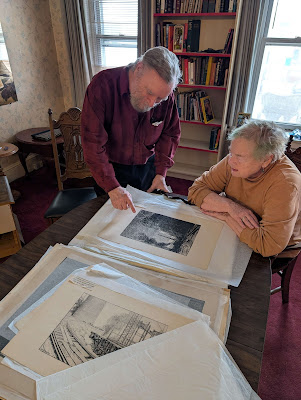.
Site Looking from River Road
While we cannot prove it and, indeed, have no evidence it is so, Marianne and I are both convinced that one of the equestrians must surely be John Fetherston, the project head/chief engineer for the nitrates plant.
After retirement, Fetherston and his wife lived in Packwood House in Lewisburg, parts of which dated back to the eighteenth century. Edith filled the house with antiques bought at auction. She "enjoyed arranging her objects in charming and whimsical combinations." After her death, in accordance to her will, a trust was created and in 1976 the Packwood Museum opened, displaying her collection of ceramics, glass, textiles, furniture, paintings, Pennsylvania German decorative arts (in this part of the world it is almost obligatory for rich people to collect fraktur and redware), and Oriental art.
Two of Bonestell's lithographs were framed and so, presumably, available for view at the auction. So they were not technically "lost." But they were not seen by anybody who had any idea what they were.
Alas, this by all accounts charming museum closed in 2020, when the Covid Isolation drove down its attendance and it could no longer pay its own way. The building went to the local historical society and its possessions, in accord with Edith's will, went to her parish church. Which had no earthly use for the and so put them for sale in several auctions. One of which was held by Pook & Pook.
"I don't know what that is, but I hope you win them," the lady at the auction house told Marianne when Marianne said that the only thing she really wanted was the Bonestells.
We had two reasons for wanting them. First, because they're terrific. Second, because we knew that if an interior decorator got hold of them, they'd be slapped in chrome frames and sold into dentists' and doctors' offices to be ignored for a few decades and then thrown away.
Luckily for us, nobody with deep pockets knew what they were, and we were able to buy them for less than what they must surely be worth.
And because we were aware of what they were, we understood that we had an obligation to share them with the world.
And for those who came in late . . .
In 1918, Chesley Bonestell was commissioned to create a series
of lithographs chronicling the construction of the government cyanamide
nitrates plant in Muscle Shoals, Alabama. It would be many years before
he began painting the astronomicals that made him famous, but he already
had tremendous technique.
The lithographs disappeared from public view not long thereafter.
Recently, my wife, Marianne Porter,
and I bought what we think is a complete set of 32 at an auction. We
had electronic files made of them, which we'll be posting here, one
every weekday until they're all online. Then we'll make a torrent
containing the complete collection in high density form, for whomever
wants them.
All the images are in public domain. You don't have to
ask anybody for permission to download them and you may employ them
however you wish.
*





























